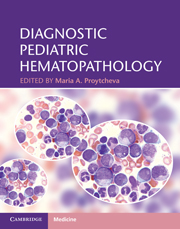Book contents
- Frontmatter
- Contents
- List of contributors
- Acknowledgements
- Introduction
- Section 1 General and non-neoplastic hematopathology
- 1 Hematologic values in the healthy fetus, neonate, and child
- 2 Normal bone marrow
- 3 Disorders of erythrocyte production
- 4 Disorders of hemoglobin synthesis
- 5 Hemolytic anemias
- 6 Inherited and acquired bone marrow failure syndromes associated with multiple cytopenias
- 7 Inherited bone marrow failure syndromes and acquired disorders associated with single peripheral blood cytopenia
- 8 Peripheral blood and bone marrow manifestations of metabolic storage diseases
- 9 Reactive lymphadenopathies
- Section 2 Neoplastic hematopathology
- Index
- References
2 - Normal bone marrow
from Section 1 - General and non-neoplastic hematopathology
Published online by Cambridge University Press: 03 May 2011
- Frontmatter
- Contents
- List of contributors
- Acknowledgements
- Introduction
- Section 1 General and non-neoplastic hematopathology
- 1 Hematologic values in the healthy fetus, neonate, and child
- 2 Normal bone marrow
- 3 Disorders of erythrocyte production
- 4 Disorders of hemoglobin synthesis
- 5 Hemolytic anemias
- 6 Inherited and acquired bone marrow failure syndromes associated with multiple cytopenias
- 7 Inherited bone marrow failure syndromes and acquired disorders associated with single peripheral blood cytopenia
- 8 Peripheral blood and bone marrow manifestations of metabolic storage diseases
- 9 Reactive lymphadenopathies
- Section 2 Neoplastic hematopathology
- Index
- References
Summary
The hematopoietic system is unique in comparison to other organ systems because its anatomic location shifts during the embryogenesis and fetal development from the yolk sac to the fetal liver and finally to the bone marrow (BM). At birth and thereafter, the hematopoiesis is restricted to the BM, which continues to evolve in order to accommodate the changing oxygenation needs of the growing child. As a result, the composition of the BM depends on the child's age – particularly early in life – as well as on the demands of the growing child, and so differs from the BM of adults. Knowledge of these differences needs to be considered when evaluating a child's BM in order to distinguish between normal development and pathologic processes.
Ontogeny of the hematopoietic system
Until definitive (adult) hematopoietic organs are fully developed, hematopoiesis occurs in successive anatomic sites where hematopoietic stem cells (HSCs) are generated, maintained, and expended to differentiate into blood cells [1, 2]. The HSCs develop from the hemangioblast, a mesoderm-derived multipotent precursor that gives rise to hematopoietic as well as endothelial and vascular smooth muscle cells [3, 4]. This process is initiated in the yolk sac between days 16 and 19 of gestation, with the formation of angioblastic foci or “blood islands” that contain primitive erythroblasts surrounded by endothelial cells. The yolk sac hematopoiesis is transient and generates HSCs that differentiate in the vasculature into primitive and definitive erythroblasts and rare macrophages.
- Type
- Chapter
- Information
- Diagnostic Pediatric Hematopathology , pp. 21 - 37Publisher: Cambridge University PressPrint publication year: 2011



